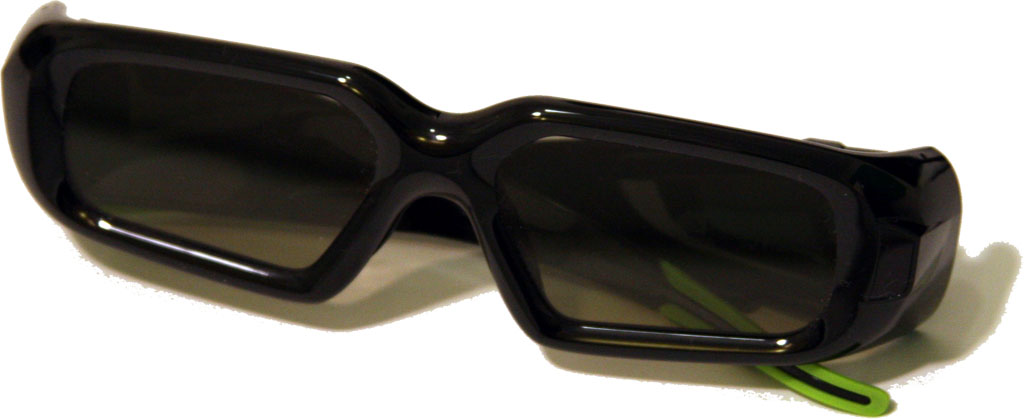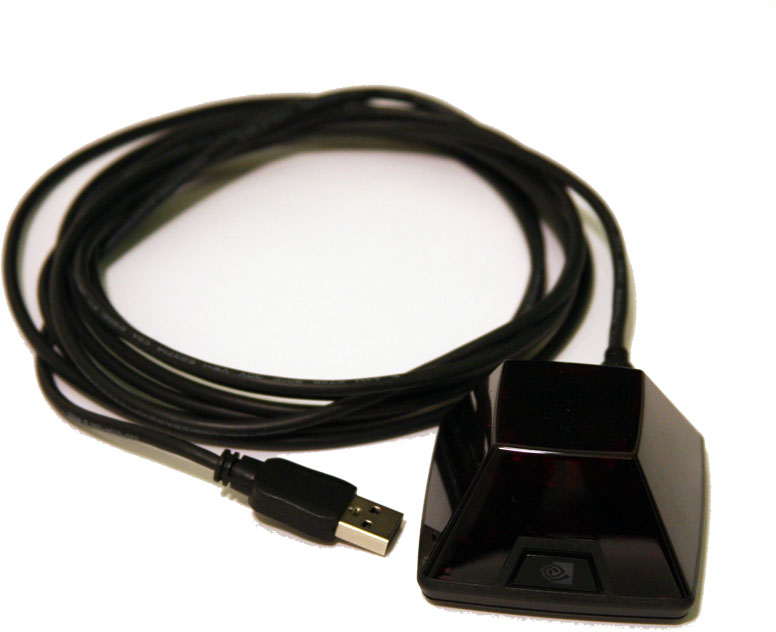GeForce 3D Vision: Gaming Goes Stereo
Stereoscopic Technology
As the word suggests, a stereo display system presents two images: one for the right eye and one for the left. Combined, they create the appearance of depth. Now, there are a couple of different ways to present stereoscopic images, both of which require eyewear.
In a passive configuration, glasses with polarized filters are used so that the left and right images are only seen by the intended eye. Because the glasses don’t contain any electronics, they’re vastly cheaper and work great for shows like "Honey, I Shrunk The Audience" at Disneyland, where a large group of people has its eyes on the screen.
An active system, in contrast, leverages electronics built into the glasses themselves, which trigger LCD shutters in rapid succession to achieve the same stereo effect. Although they’re more complex (and thus, expensive), an active system delivers more resolution per eye and a wider viewing angle than passive glasses do, according to Nvidia. Like the Elsa Revelators we first experienced 10 years ago, Nvidia’s GeForce 3D Vision kit is consequently active as well.
The GeForce 3D Vision Kit
But priced at $199, we’re a long way away from the TNT2 bundles seen a decade ago. The standalone kit includes wireless glasses, an infrared emitter responsible for communicating with the glasses, a DVI-to-HDMI cable used with DLP HDTVs, a pair of USB cables for connecting the emitter and charging the glasses, a VESA three-pin stereo cable used to sync with a DLP, a protective pouch, and a pair of nose pieces that offer a slightly different fit.
The glasses themselves certainly aren’t stylish, but they won’t land you on Page Six of The New York Post, either. More important, they’re actually light and comfortable, despite the electronics contained within. The ends of each frame are rubberized for a snug grip on the sides of your head, and if the stock nose piece doesn’t fit well, one of the two others should work better. Turning the shades on is as simple as pressing a small power button on the frame. And after 10 minutes of inactivity, they’ll automatically shut down. It takes three hours to fully charge the built-in battery and 40 hours of continuous use to fully drain them. We weren’t able to get 40 hours of testing in, but after going through seven games, we’re still on the first charge and they’re holding up well.
Control over the glasses is exercised by an included IR emitter, which has a 20-foot range and supports as many sets of shades as you feel like buying. The front of the transmitter sports a simple on/off button. The back sports a USB port that hooks up to your PC, a power indicator, a VESA cable port (in case you use the glasses with a DLP), and a thumbwheel to adjust depth (eye separation). By default, the depth setting is 15%, but we found that, in certain games, adjusting depth up or down (usually down) improved the experience.
Get Tom's Hardware's best news and in-depth reviews, straight to your inbox.
Everything else in the package is complementary. USB cables are used to attach the IR emitter and to charge the glasses between uses. The DVI and VESA cables are only necessary if you use a DLP TV. And the storage pouch simply protects the glasses, which are actually glass and can be scratched if you leave them lying around.
-
TheGreatGrapeApe Interesting, but I'm surprised that this came out before an updated and finalized GTX295 review.Reply
nV's recent flurry of 3D stereo-vision and Charlie @ the InQ's pre-emptive bashing of it have been interesting, but it reminds me of Matrox's wonderful surround-view feature, which is great, but it's still niche and will remain so.
Not my cuppa, but at least the tech is moving forward so who knows about the future.
I'm one of those people who see the rainbow effect on Gen3 DLP screens with 360hz colour wheels, so I have a feeling these new glasses won't improve the headaches anymore than the faster wheel solved my rainbow vision. Now synch some shutter glasses on a 480hz plasma... ;)
-
Nice article, but you're forgetting about something...Pc's are not only used for gaming, and if NVidia wants to make this really popular they MUST find a way to make movies work with their glasses.Currently there are very few titles that are in 3D, most are old, and the new ones are expensive, and so far converting a regular movie to stereoscopic 3D is almost impossible, and the quality is not what you'd expect. Also...besides providing their own hardware and a new Vista compatible driver, what did NVidia came up with that surpasses all the other 3D shutter glasses on the market(eDymensional..etc.), giving to account that all the titles you tested work with/the same(look,FPS etc.)with any stereoscopic glasses?Reply
-
cangelini TheGreatGrapeApeInteresting, but I'm surprised that this came out before an updated and finalized GTX295 review.nV's recent flurry of 3D stereo-vision and Charlie @ the InQ's pre-emptive bashing of it have been interesting, but it reminds me of Matrox's wonderful surround-view feature, which is great, but it's still niche and will remain so. Not my cuppa, but at least the tech is moving forward so who knows about the future.I'm one of those people who see the rainbow effect on Gen3 DLP screens with 360hz colour wheels, so I have a feeling these new glasses won't improve the headaches anymore than the faster wheel solved my rainbow vision. Now synch some shutter glasses on a 480hz plasma...Reply
Grape,
It's coming. I sent all of the hardware to Thomas, who has a second GTX 295, which means we'll be able to deliver benchmarks of two 295s versus a pair of X2s and so on down the line. I'm over at CES, so all of this had to be finished up before the show. Should be worth the wait. I'm looking forward to see what four-digits worth of graphics horsepower is capable of, to be sure.
I had the chance to check out Nvidia's competition tonight at the show and am currently working on a news story about it. Not. Impressed. -
enewmen This brings be back to the Asus V6600 GeForce Deluxe card I got in 1999. At that time, the 'Dagoth More Zoological Gardens' with the VR-Glasses was the most awesome sight I've ever seen on a PC. This worked with Ultima9 as well as a nice surpirse :)Reply
I'm surprised I havin't seen (mainstream) 3-D displays without glasses yet. I've seen some samples of this in the past with small screens. -
cangelini Totally remember that myself. That was actually one of the first video cards I ever reviewed =)Reply -
This reminds me that Sony showed a stereo version of Gran Turismo 5 running on a PS3 AND that the RSX is a NVidian board...Reply
-
LCD shutter glasses again??? Really? Yawn. Where are the glasses that beam images directly onto my retinas or even a set of lcd glasses that are actually 2 tiny HD monitors but still light enough to wear comfortably...Reply
-
Fadamor I need to point out an apparent error in nVidia's statement regarding TV's... I purchased a Samsung 40" LCD TV (Model number LN40A650) just prior to the holidays that has 120 Hz HDMI ports (4 of them) AND has 120 Hz refresh rate. So there ARE large screens out there that should be able to support the 3D technology.Reply -
GlItCh017 gmt325ghnice... just one small problem .... what about people who wear glasses ???!!!Reply
I would guess that it fits over glasses.


